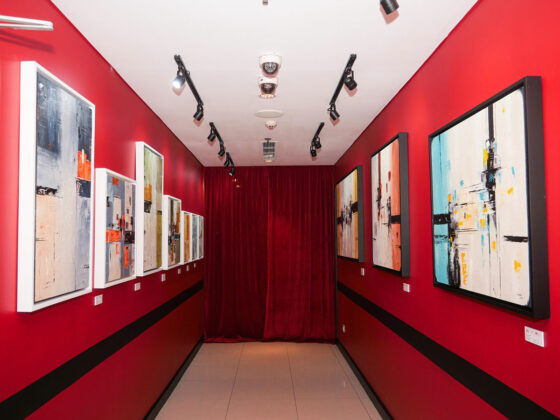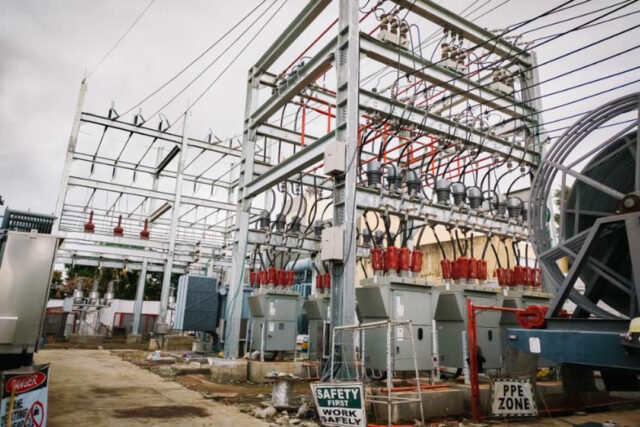By Chloe Mari A. Hufana, Reporter
Concert Review
GUTS
Featuring Olivia Rodrigo
Oct. 5, 2024
Philippine Arena, Bulacan
FILIPINO-AMERICAN popstar Olivia Rodrigo’s sold-out one-night concert, GUTS, held at the Philippine Arena on Oct. 5, was a visual and musical spectacle that saw the singer serenading 55,000 fans with her raw lyrical storytelling and vocal prowess. Her biting lyrics and infectious attitude seemed to spill into the audience during the entire two-hour show, unleashing a torrent of unapologetic emotion. This was Olivia Rodrigo at her most punk — edgy, loud, and defiant.
Ms. Rodrigo’s inaugural performance on home soil was her biggest since she kicked off the GUTS Tour in February. The multiple Grammy winning singer-songwriter, whose father is Filipino, proved her “Pinoy Pride” as the Manila leg of the show had tickets priced at a flat rate of P1,500 for the sake of her fans. All net proceeds from the show will go to Ms. Rodrigo’s “fund 4 good.”
According to the Entertainment Industry Foundation’s website, Ms. Rodrigo’s fund 4 good is “a global initiative committed to building an equitable and just future for women and girls through direct support of community-based non-profits that champion girls’ education, support reproductive rights and prevent gender-based violence.”
The net proceeds of the Manila stop will go to the non-profit organization Jhpiego in Manila, which provides healthcare to women and girls in the country.
“I’m SO stoked that all the net ticket sales from last night could be donated to @jhpiego through my fund 4 good,” she wrote in an Instagram post after her show.
“It was the most special show and the most meaningful trip. To say I’m grateful doesn’t even cut it! Mahal kita,” she ended.
EMOTION-FILLED PERFORMANCES
The setlist was balanced with the highs of teenage angst and lows of introspection. She set the tone of the show with “bad idea right?” from her sophomore album GUTS, which made the arena shake as the riotous sing-along was followed by “ballad of a homeschooled girl” from the same album.
From that frenetic pace, the 21-year-old singer went on to haunt the crowd with the biting, vulnerable lyrics of “vampire” and “traitor” from her debut album SOUR. While the tunes were mellow, the lyrics shouted betrayal and disillusionment.
Ms. Rodrigo, a self-confessed romantic, has established a penchant for raw lyricism which often features her personal experiences. When she sang her 2021 hit “drivers license” before the crowd, it felt like she was singing not just for herself, but for every broken heart in the packed arena.
The songs “teenage dream” and “pretty isn’t pretty” are both bittersweet depictions of navigating identity. Both anthems of growing up and chasing perfection, with them the former Disney star has perfectly captured the anxiety of teenagers, making her more relatable.
Staying true to her reputation of raw honesty, she followed these up with “love is embarrassing” and “making the bed” which show different faces of vulnerability. One is a fun, upbeat track that captures the awkward and cringey moments of love, while the other is a melancholic open diary that explores feelings of dissatisfaction and self-blame.
She followed the somber tune by sitting atop a crescent moon and flying over the arena while singing “logical” and “enough for you.” She ended the train of pensive tunes with “lacy,” detailing more of her insecurity as she struggles with self-image.
The flying-while-sitting-on-the-moon moment was the perfect transition into the rest of the show as the songs got edgier. Crowd-favorite “so american” was extra special as she pointed to her British boyfriend, actor Louis Partridge, who was in the crowd, during the chorus.
She followed up with four songs from her debut album: “jealousy, jealousy,” “happier,” “favorite crime,” and her hit “deja vu,” all of which candidly detail the insecurities that come with constantly measuring oneself against others.
The last forlorn melody in her setlist was “the grudge,” a haunting exploration of resentment and unresolved pain.
A trio of songs — “brutal,” “obsessed,” and “all american bitch” — were a train of riotous, punk rock anthems that electrified the packed venue. The Filipino American superstar worked up the crowd with her rebellious energy, blending her grit and distorted guitars.
Wearing a white tank top sporting the words “Pinoy Pride” for the last part of the show, the singer ended the 23-song setlist with “good 4 u” from her debut album and “get him back!” from her sophomore record. The crowd roared as they screamed the lyrics out, each line dripping with unapologetic intensity as the singer unleashed her final burst of energy — a perfect finale as Ms. Rodrigo did not just perform; she bared her soul.
BITTER PRE-CONCERT EXPERIENCE
While the show itself was wonderful, the pre-show experience was another thing entirely as the low ticket price drew scalpers and spawned a wild speculative environment.
Avid concertgoer Czarina Lyn V. Buñag shared her disappointment with her experience before and during the concert, saying the “scalper culture” in the Philippines soured the well-intentioned concert.
“The ticket selling was actually interesting [because] it was only for P1,500 and it goes for a good cause but this kind of concert being held here in the Philippines did not go well… A lot of scalpers got to secure tickets and people with connections secured their slots in the VIP section which was unfair for a lot of the fans,” she told BusinessWorld on the concert day.
She said she saw a lot of resellers online selling tickets for as much as P15,000.
“Up until the ticket claims, [many were] selling their tickets depending on the section revealed. Then there are these scammers where they grab photos of tickets from random people and pretend that they are selling these for the right amount of price,” she added, calling her GUTS Tour experience worse than her experience at the Taylor Swift Eras Tour concert in Singapore.
“People in this country think so much about the money they can earn through scamming or securing tickets they don’t really want.”
While a person with a disability, Ms. Buñag was not given priority at the queue in the Philippine Arena because her friends did not require special assistance. As a result, she had to endure hours of waiting in line as she was barred from priority access inside the venue.
Prior to the ticket selling, GUTS Tour organizer Live Nation PH said every ticket would be stamped with the name of the buyer and would require identification cards to claim before entering the venue, all in an effort to fight scalper culture. However, the attempt to check that every ticketholder matched their ticket faded quickly as the staff was overwhelmed with excited fans. In the end, they just let everyone through without even checking ID cards and tickets.
As Ms. Rodrigo wraps the Asian leg of her tour, fans hope that the bitter pre-concert experiences of many will not overshadow the success of her show.
In the end, Olivia Rodrigo’s GUTS Tour in the Philippines was more than just a concert — it was a night where Pinoy pride and a punk attitude collided, creating a memory that fans will cherish long after the last note faded away. It was a night of catharsis, a celebration of angst, vulnerability, and empowerment. She is a force to be reckoned with — and she is just beginning.





















